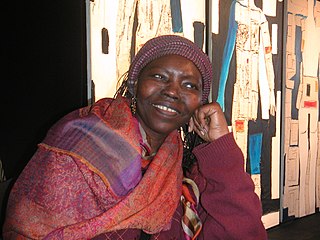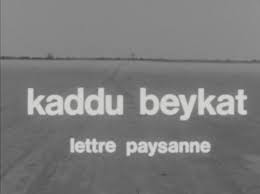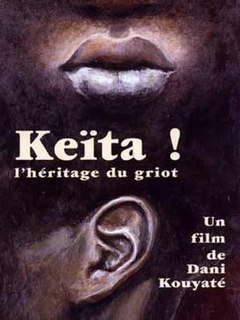
Idrissa Ouédraogo was a Burkinabé filmmaker. His work often explored the conflict between rural and city life and tradition and modernity in his native Burkina Faso and elsewhere in Africa. He is best known for his feature film Tilaï, which won the Grand Prix at the 1990 Cannes Film Festival and Samba Traoré (1993), which was nominated for the Silver Bear award at the 43rd Berlin International Film Festival.
The cinema of Burkina Faso is one of the more significant in Africa, with a history that spans several decades and includes the production of many award-winning films.
The Panafrican Film and Television Festival of Ouagadougou is a film festival in Burkina Faso, held biennially in Ouagadougou, where the organization is based. It accepts for competition only films by African filmmakers and chiefly produced in Africa. FESPACO is scheduled in March every second year, two weeks after the last Saturday of February. Its opening night is held in the Stade du 4-Août, the national stadium.

Gaston Kaboré is a Burkinabé film director and an important figure in Burkina Faso's film industry. He has won awards for his films Wend Kuuni and Buud Yam.

Cinema of Africa is both the history and present of the making or screening of films on the African continent, and also refers to the persons involved in this form of audiovisual culture. It dates back to the early 20th century, when film reels were the primary cinematic technology in use. During the colonial era, African life was shown only by the work of white, colonial, Western filmmakers, who depicted Africans in a negative fashion, as exotic "others". As there are more than 50 countries with audiovisual traditions, there is no one single 'African cinema'. Both historically and culturally, there are major regional differences between North African and sub-Saharan cinemas, and between the cinemas of different countries.

The Voulet–Chanoine Mission or Central African-Chad Mission was a French military expedition sent out from Senegal in 1898 to conquer the Chad Basin and unify all French territories in West Africa. This expedition operated jointly with two other expeditions, the Foureau-Lamy and Gentil missions, which advanced from Algeria and Middle Congo respectively. The refusal of the expedition commander and his second-in-command to follow orders from France, their murder of a commanding officer and their subsequent deaths at the hands of their own soldiers cast a dark shadow over France's emerging colonial empire in Africa at the end of the 19th century. The expedition is remembered for its descent into depravity and extreme violence, actions which today would legally be considered war crimes.
Sarraounia Mangou was a chief/priestess of the animist Azna subgroup of the Hausa, who fought French colonial troops of the Voulet–Chanoine Mission at the Battle of Lougou in 1899. She is the subject of the 1986 film Sarraounia based on the novel of the same name by Nigerien writer Abdoulaye Mamani.
Oumarou Ganda was a Nigerien director and actor who helped bring African cinema to international attention in the 1960s and 1970s.
The Cinema of Niger began in the 1940s with the ethnographical documentary of French director Jean Rouch, before growing to become one of the most active national film cultures in Francophone Africa in the 1960s-70s with the work of filmmakers such as Oumarou Ganda, Moustapha Alassane and Gatta Abdourahamne. The industry has slowed somewhat since the 1980s, though films continue to be made in the country, with notable directors of recent decades including Mahamane Bakabe, Inoussa Ousseini, Mariama Hima, Moustapha Diop and Rahmatou Keïta. Unlike neighbouring Nigeria, with its thriving Hausa and English-language film industries, most Nigerien films are made in French with Francophone countries as their major market, whilst action and light entertainment films from Nigeria or dubbed western films fill most Nigerien theatres.

Safi Faye is a Senegalese film director and ethnologist. She was the first Sub-Saharan African woman to direct a commercially distributed feature film, Kaddu Beykat, which was released in 1975. She has directed several documentary and fiction films focusing on rural life in Senegal.

Kaddu Beykat is a 1975 Senegalese film directed by Safi Faye. It was the first feature film made by a Black African woman to be commercially distributed and brought international recognition for its director. Centred on a romance, it chronicles the daily lives of people in a rural Senegalese village.

Le Wazzou polygame is a 1971 Nigerien/French film about polygamy directed by and starring Oumarou Ganda. It was produced by Argos Films in France. It won the Grand Prize at the 1972 Panafrican Film and Television Festival of Ouagadougou and was the first official winner of that festival.
Ecrans d'Afrique: Revue Internationale de Cinema Television et Video, founded by African filmmakers in Burkina Faso in 1992 during a period of intense worldwide interest and commentary on African T.V. and film, explored all aspects of African film production. It, along with its many contemporaries, sought to ameliorate an intellectual climate which suffered from a dearth of commentary on African film. A corollary of the journal's efforts was to improve worldwide exposure and access to African films - it was linked to the Panafrican Film and Television Festival of Ouagadougou (FESPACO), the continent's leading film festival, from its inception. Ecrans d'Afrique has also been lauded for its wide gaze covering the whole of the African diaspora and for its excellent coverage of Caribbean film developments.

Dani Kouyaté is a film director and griot from Burkina Faso, which the BBC describes as "Africa's most important film-making country".

Keïta! l'Héritage du griot is a 1995 Burkinabé film directed by Dani Kouyaté and starring Sotigui Kouyaté. It is an adaptation of the first third of the 13th-century Epic of Sundiata, interspersed with scenes of a griot telling the story to a young child.
Konni is a traditional Hausa state in what is today south central Maradi Region Niger and north Sokoto State Nigeria. It continues to exist as a ceremonial polity centered on the Nigerien city of Birni-N'Konni.

Med Hondo was a Mauritanian-born French actor, producer, screenwriter and film director. He emigrated to France in 1959 and began to work in film during the 1960s. He received critical acclaim for his 1970 directorial début Soleil O.
Ola Balogun is a Nigerian filmmaker and scriptwriter. He also ventured into the Nigerian music industry in 2001. Balogun, who has been making films for more than three decades, is part of the first generation of Nigerian filmmakers.
Abdoulaye Mamani (1932–1993) was a Nigerien poet, novelist and trade unionist.
Zalika Souley was a Nigerien actress, the first sub-Saharan movie actress, and one of the pioneering actresses of African cinema.










